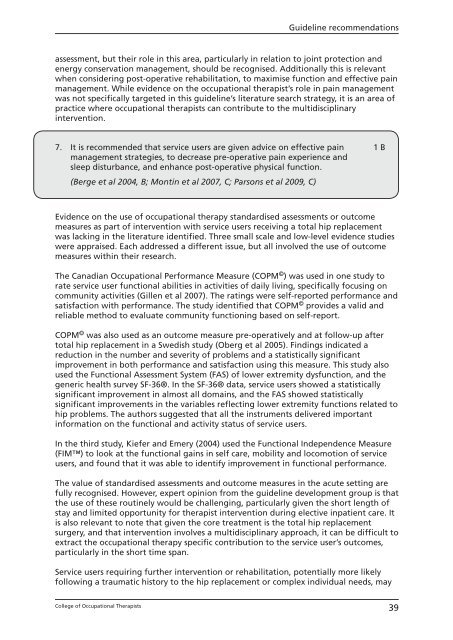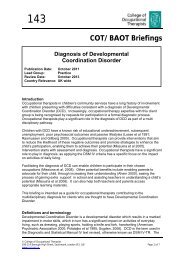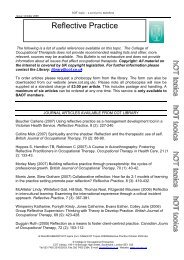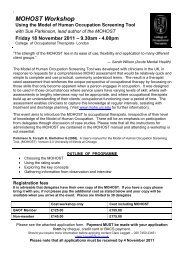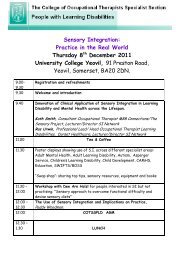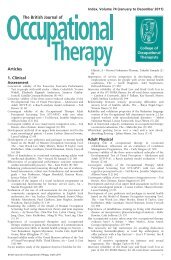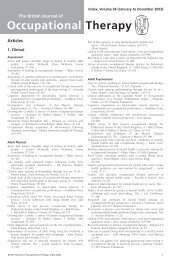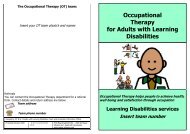Total hip replacement - College of Occupational Therapists
Total hip replacement - College of Occupational Therapists
Total hip replacement - College of Occupational Therapists
You also want an ePaper? Increase the reach of your titles
YUMPU automatically turns print PDFs into web optimized ePapers that Google loves.
Guideline recommendations<br />
assessment, but their role in this area, particularly in relation to joint protection and<br />
energy conservation management, should be recognised. Additionally this is relevant<br />
when considering post- operative rehabilitation, to maximise function and effective pain<br />
management. While evidence on the occupational therapist’s role in pain management<br />
was not specifically targeted in this guideline’s literature search strategy, it is an area <strong>of</strong><br />
practice where occupational therapists can contribute to the multidisciplinary<br />
intervention.<br />
7. It is recommended that service users are given advice on effective pain<br />
management strategies, to decrease pre- operative pain experience and<br />
sleep disturbance, and enhance post- operative physical function.<br />
(Berge et al 2004, B; Montin et al 2007, C; Parsons et al 2009, C)<br />
1 B<br />
Evidence on the use <strong>of</strong> occupational therapy standardised assessments or outcome<br />
measures as part <strong>of</strong> intervention with service users receiving a total <strong>hip</strong> <strong>replacement</strong><br />
was lacking in the literature identified. Three small scale and low-level evidence studies<br />
were appraised. Each addressed a different issue, but all involved the use <strong>of</strong> outcome<br />
measures within their research.<br />
The Canadian <strong>Occupational</strong> Performance Measure (COPM © ) was used in one study to<br />
rate service user functional abilities in activities <strong>of</strong> daily living, specifically focusing on<br />
community activities (Gillen et al 2007). The ratings were self- reported performance and<br />
satisfaction with performance. The study identified that COPM © provides a valid and<br />
reliable method to evaluate community functioning based on self- report.<br />
COPM © was also used as an outcome measure pre- operatively and at follow- up after<br />
total <strong>hip</strong> <strong>replacement</strong> in a Swedish study (Oberg et al 2005). Findings indicated a<br />
reduction in the number and severity <strong>of</strong> problems and a statistically significant<br />
improvement in both performance and satisfaction using this measure. This study also<br />
used the Functional Assessment System (FAS) <strong>of</strong> lower extremity dysfunction, and the<br />
generic health survey SF- 36®. In the SF- 36® data, service users showed a statistically<br />
significant improvement in almost all domains, and the FAS showed statistically<br />
significant improvements in the variables reflecting lower extremity functions related to<br />
<strong>hip</strong> problems. The authors suggested that all the instruments delivered important<br />
information on the functional and activity status <strong>of</strong> service users.<br />
In the third study, Kiefer and Emery (2004) used the Functional Independence Measure<br />
(FIM) to look at the functional gains in self care, mobility and locomotion <strong>of</strong> service<br />
users, and found that it was able to identify improvement in functional performance.<br />
The value <strong>of</strong> standardised assessments and outcome measures in the acute setting are<br />
fully recognised. However, expert opinion from the guideline development group is that<br />
the use <strong>of</strong> these routinely would be challenging, particularly given the short length <strong>of</strong><br />
stay and limited opportunity for therapist intervention during elective inpatient care. It<br />
is also relevant to note that given the core treatment is the total <strong>hip</strong> <strong>replacement</strong><br />
surgery, and that intervention involves a multidisciplinary approach, it can be difficult to<br />
extract the occupational therapy specific contribution to the service user’s outcomes,<br />
particularly in the short time span.<br />
Service users requiring further intervention or rehabilitation, potentially more likely<br />
following a traumatic history to the <strong>hip</strong> <strong>replacement</strong> or complex individual needs, may<br />
<strong>College</strong> <strong>of</strong> <strong>Occupational</strong> <strong>Therapists</strong><br />
39


